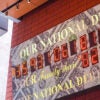The United Nations has responded in several ways to the Libyan regime’s terrible acts over the past few weeks. None of those actions, including the premature referral of Libyan to the International Criminal Court, have seemingly given Muammar Qadhafi much concern. Attacks continue, people are dying, and Qadhafi remains intent to stay in power. The carnage has increased calls for the United States and other countries to intervene in Libya by imposing a no-fly zone or undertaking more robust actions. Indeed. The U.S., France and the United Kingdom are reportedly working on a new Security Council resolution that would authorize a no-fly zone over Libya.
This raises a fair question. Why didn’t the U.S. envision this possibility when it was negotiating Security Council resolution 1970 that imposes sanctions on Libya, which passed last week? NGOs and governments raised the possibility of a no-fly zone for Libya even before the text of resolution 1970 was finalized. Yet, the text of resolution 1970 specifically does not authorize military intervention, even to protect civilians or prevent atrocities. On the contrary, the resolution reaffirms the Security Council’s “strong commitment to the sovereignty, independence, territorial integrity and national unity of the Libyan Arab Jamahiriya.”
The actions of the Administration in seeking a new resolution confirm that, in their view, a no-fly zone would require specific authorization under an additional resolution. But, based on their long-held position of opposing external interference in sovereign territory, China and Russia (which can veto Security Council resolutions) are unlikely to approve foreign interventions in Libya, including a no-fly zone. Getting a new resolution passed will be a tough struggle that may not succeed. Would the administration be willing to act without Security Council authorization as President George W. Bush did in Iraq and President Bill Clinton did in Yugoslavia? It’s too early to say. But, aside from the U.K., the Europeans are unlikely to go along the U.S., should the administration cross that bridge.
Moreover, resolution 1970 establishes an arms embargo for the “Libyan Arab Jamahiriya”. The resolution consistently uses “Libyan Arab Jamahiriya” to identify a physical territory and “Libyan authorities” to identify Qadhafi’s government. This distinction is important because some members of Congress are suggesting that the U.S. should offer support for the Libyan rebels. But the arms embargo adopted in resolution 1970 is comprehensive over the territory of the Libyan Arab Jamahiriya. The arms embargo does not specify the Libyan authorities as its target nor does it specifically exempt arms or military assistance to individuals or groups outside of the Libyan authorities. Moreover, there is a specific list of exempted items, so it cannot be said that the exemptions were not considered. In short, resolution 1970 appears to prohibit all military support to anyone in Libya, including Qadhafi’s forces and the rebels, unless approved by the new Sanctions Committee (comprised of the members of the Security Council, naturally) set up by resolution 1970.
There are legitimate questions over whether the no-fly zone is possible, practical, or suitable. There are also enormous uncertainties about the motivations, composition, and coherence of Libya’s rebels that raise concerns about whether and to what extent they should be supported. However, one thing is clear. In a fluid situation, it is prudent to keep your options open. The Obama administration did exactly the opposite in supporting resolution 1970. America’s options are now more constrained and the path to their implementation more obstructed than would have been the case with better foresight.






























4 Replies to “UN Security Council Resolution on Libya Lacks Foresight”